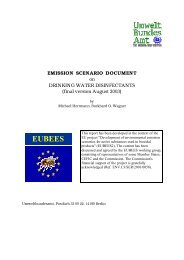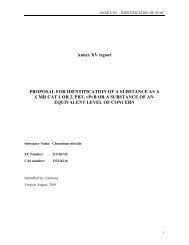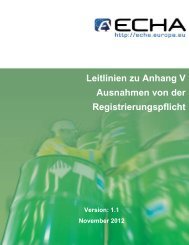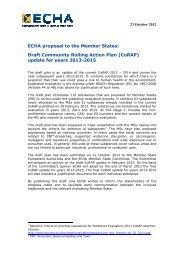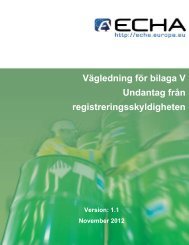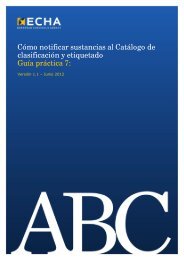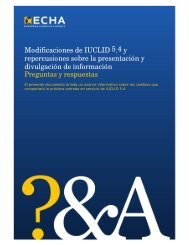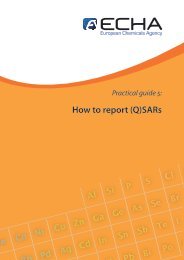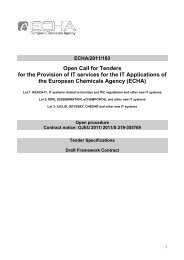Strategy For Limiting Risks Human Health Draft of ... - ECHA - Europa
Strategy For Limiting Risks Human Health Draft of ... - ECHA - Europa
Strategy For Limiting Risks Human Health Draft of ... - ECHA - Europa
You also want an ePaper? Increase the reach of your titles
YUMPU automatically turns print PDFs into web optimized ePapers that Google loves.
2 The Risk Assessment<br />
2.1 Workers<br />
Introductory remarks<br />
Occupational exposure to cryolite may occur during production and further processing and<br />
use <strong>of</strong> the substance. This risk assessment is based upon the occupational exposure<br />
assessment (RAR-chapter 4.1.1.2) and the toxicological pr<strong>of</strong>ile <strong>of</strong> cryolite (RAR-chapter<br />
4.1.2). The threshold levels identified in the hazard assessment are taken forward to<br />
characterise the risks at the workplace and give indication for concern according to the MOS<br />
approach as outlined in the TGD (<strong>Human</strong> <strong>Health</strong> Risk Characterisation, Final <strong>Draft</strong>).<br />
Systemic availability for different routes <strong>of</strong> exposure<br />
<strong>For</strong> cryolite information on absorption mainly comes from fluoride determination (F⎯) in<br />
excrements (animal or human studies) after oral application. Very little is known on the<br />
absorption and bioavailability <strong>of</strong> the aluminium-containing moiety. On the background <strong>of</strong> the<br />
fluoride data the oral absorption in humans is assumed to be 95 % based on the study <strong>of</strong><br />
Largent and Heyroth (Largent and Heyroth, 1948). <strong>For</strong> animals, 85 % oral absorption is taken<br />
for risk characterisation in animals (rats) based on the study <strong>of</strong> Wright and Thompson (1978).<br />
Inhalation data are rare but give indication that also after inhalation <strong>of</strong> cryolite dust a<br />
considerable amount <strong>of</strong> F⎯ may be absorbed. <strong>For</strong> inhalation a default value <strong>of</strong> 100 %<br />
absorption is taken forward to worker risk assessment. <strong>For</strong> dermal absorption no data are<br />
available. A value <strong>of</strong> 10% for dermal absorption <strong>of</strong> cryolite is assumed, because cryolite is<br />
insoluble in organic solvents and thus will not easily pass the lipophilic stratum corneum <strong>of</strong><br />
the skin. Furthermore, salts are usually poorly absorbed via the dermal route. In all cases it<br />
has to be recognised, that the information on absorption only applies to the F⎯ content <strong>of</strong> the<br />
cryolite molecule.<br />
Occupational exposure and internal body burden<br />
In table 2.1 the exposure levels <strong>of</strong> the RAR-table 4.1 which concern cryolite are summarised<br />
and the route-specific internal body burdens <strong>of</strong> F⎯ are identified. To this end the F⎯-content in<br />
cryolite <strong>of</strong> 54% is taken into account in combination with the route-specific percentages for<br />
absorption (100 % for inhalation and 10 % for dermal exposure). <strong>For</strong> combined exposure the<br />
internal body burdens <strong>of</strong> F⎯ by inhalation and dermal contact are summed up to give a total<br />
internal body burden.<br />
12






